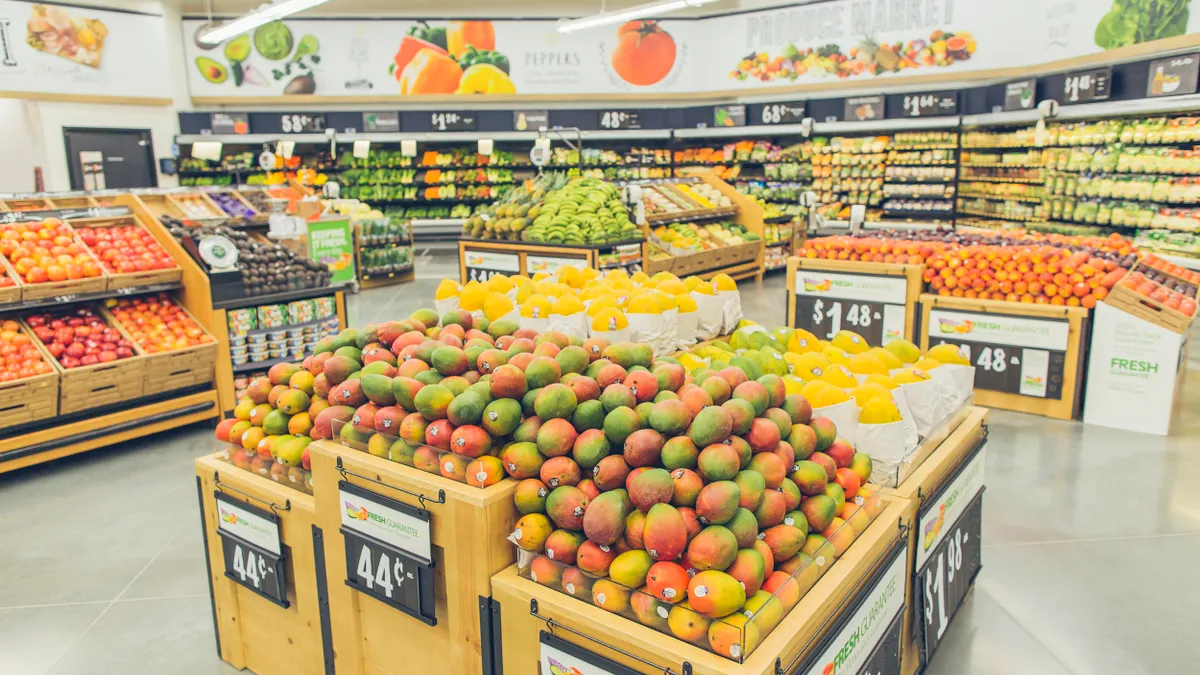Dive Brief:
- Sales for traditional grocers fell 1.1% to $547.6 billion in 2018 and market share dropped to about 44% of overall grocery sales, according to Inmar Analytics' new 2019 Future of Food Retailing Report. Store count for super warehouses fell 5.1% while annual sales fell 7.4% and dollar share dropped 10%.
- Non-traditional grocers now control 40% of the market share, with sales in the category growing 1.9% to $500.6 billion. Dollar stores and wholesale clubs lead the way in non-traditional sales gains. Drug stores saw a decline of 6% in food and consumables, and convenience store sales grew 2.2%, though store count dipped by 1.1%.
- E-Commerce sales increased 21.7% in 2018 to $58 billion, the report found. Amazon continued to lead sales in the e-commerce space for food and consumables, with a year-over-year increase of 23.5%, despite a growing number of e-commerce options among traditional retailers.
Dive Insight:
While Inmar found that traditional grocery stores still have the largest share of the market, it has dropped drastically from the 90% share traditional grocery once held. Those stores are increasingly losing dollar share to supercenters and wholesale clubs, led by Walmart, Target and Costco, and dollar stores like Dollar General.
Fresh format stores are a bright spot in the traditional channel. This category saw a steady increase in sales in 2018, growing 3.6% to $30.7 billion. Not only has the number of these stores increased by 3.4%, but the dollar share has increased as well. Kroger’s smaller format Fresh Eats MKT, Albertsons' Star Market, Hy-Vee's Fast & Fresh and Giant Heirloom give consumers added convenience with amenities like bulk foods, prepared meals, eat-in locations and a wider assortment of fresh produce. Traditional stores are turning to fresh formats to adapt to the changing marketplace and tweak the models that have worked for them in the past.
Dollar store formats continue to find success among non-traditional formats. Inmar’s report found sales grew 5.7% in 2018 and market share grew by 3.4%. Dollar General is a prime example. In 2018, the company reported its 29th straight year of growth — one that can’t be matched by any major U.S. grocery retailer. In combining convenience with low prices, Dollar General has made itself the largest U.S. retail chain by store count, and its CEO plans to keep growing. What's more, a recent study that found the quality of fruits and vegetables at discount stores is just as good as, and less expensive than, grocery store produce. These elements have primed dollar stores to continue to eat into traditional stores' market share.
Unsurprisingly, e-commerce is still gaining ground as sales increase. This is partly because more traditional retailers are implementing e-commerce, but also because more shoppers are becoming comfortable with the channel. Research released in August found that it's not just millennials and Generation Z consumers buying online — 60% of Generation X and baby boomer shoppers surveyed have ordered groceries online for home delivery.
While overall the non-traditional category is growing, there have been challenges for drug stores. Sales and store counts are falling, and recent mergers among banners haven't necessarily benefited food sales. Tie-ups like the one between Kroger and Walgreens could help drug stores change course if the companies successfully scale their grocery offerings and attract more customers.












